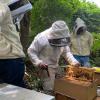Land Cover & Forest Formation Distributions for St. Kitts, Nevis, St. Eustatius, Grenada & Barbados from Decision Tree Classification (2008)
Satellite image-based mapping of tropical forests is vital to conservation planning. Standard
methods for automated image classification, however, limit classification detail in complex tropical landscapes. In this study, we test an approach to Landsat image interpretation on four islands of the Lesser Antilles, including Grenada and St. Kitts, Nevis and St. Eustatius, testing a more detailed classification than earlier work in the latter three islands. Secondly, we estimate the extents of land cover and protected forest by formation for five islands and ask how land cover has changed over the second half of the 20th century. The image interpretation approach combines image mosaics and ancillary geographic data, classifying the resulting set of raster data with decision tree software. Cloud-free image mosaics for one or two seasons were created by applying regression tree normalization to scene dates that could fill cloudy areas in a base scene. Such mosaics are also known as cloud-filled, cloud-minimized or cloud-cleared imagery, mosaics, or composites.
The approach accurately distinguished several classes that more standard methods would confuse; the seamless mosaics aided reference data collection; and the multiseason imagery allowed us to separate drought deciduous forests and woodlands from semi-deciduous ones. Cultivated land areas declined 60 to 100 percent from about 1945 to 2000 on several islands. Meanwhile, forest cover has increased 50 to 950%. This trend will likely continue where sugar cane cultivation has dominated. Like the island of Puerto Rico, most higher-elevation forest formations are protected in formal or informal reserves. Also similarly, lowland forests, which are drier forest types on these islands, are not well represented in reserves. Former cultivated lands in lowland areas could provide lands for new reserves of drier forest types. The land-use history of these islands may provide insight for planners in countries currently considering lowland forest clearing for agriculture.
Area of interest: Grenada
Year: 2008




